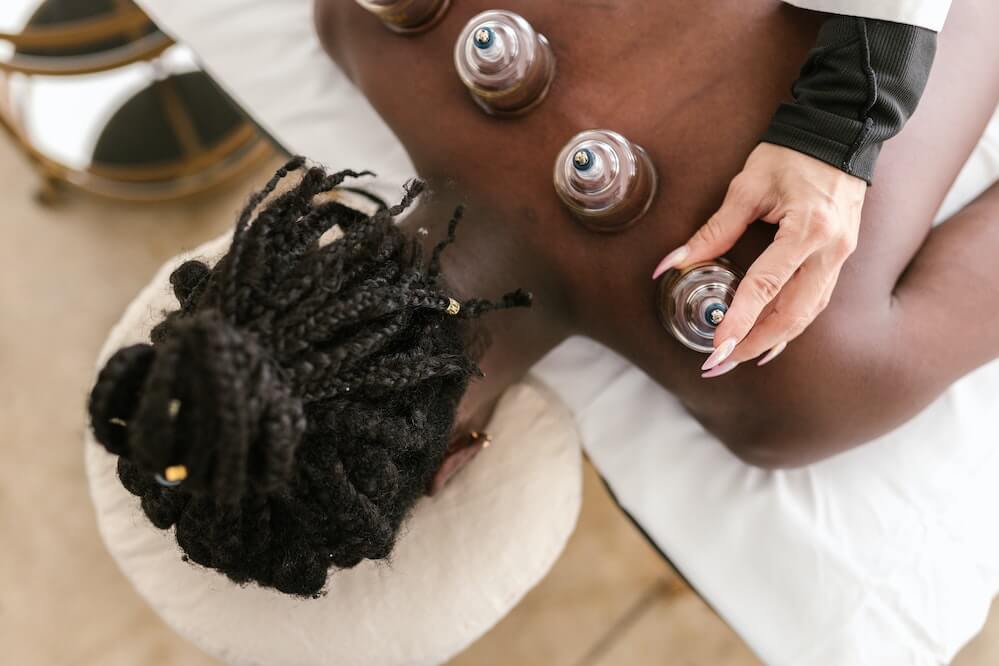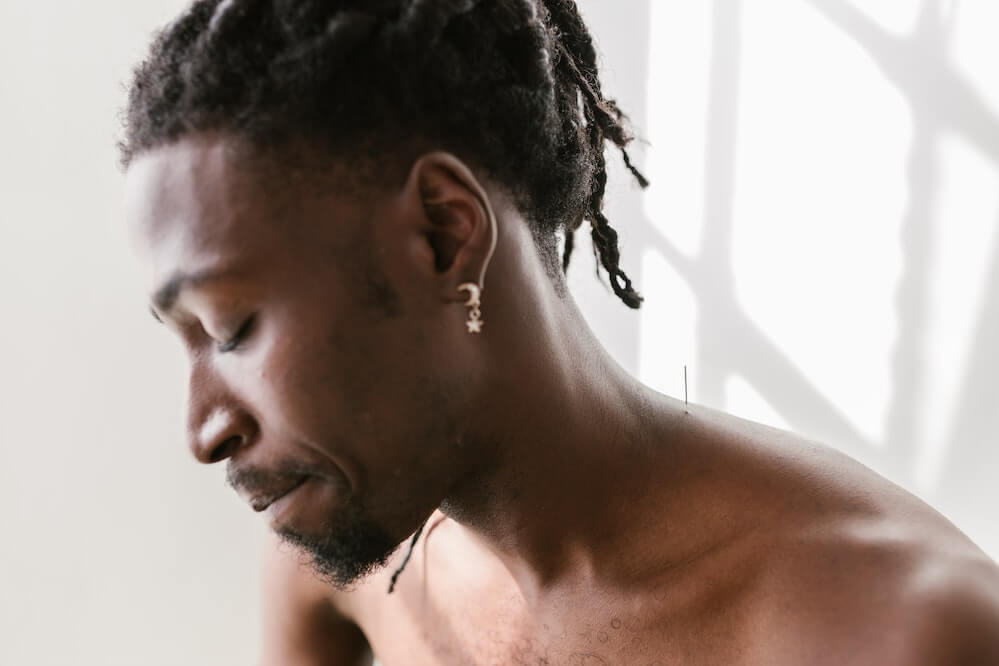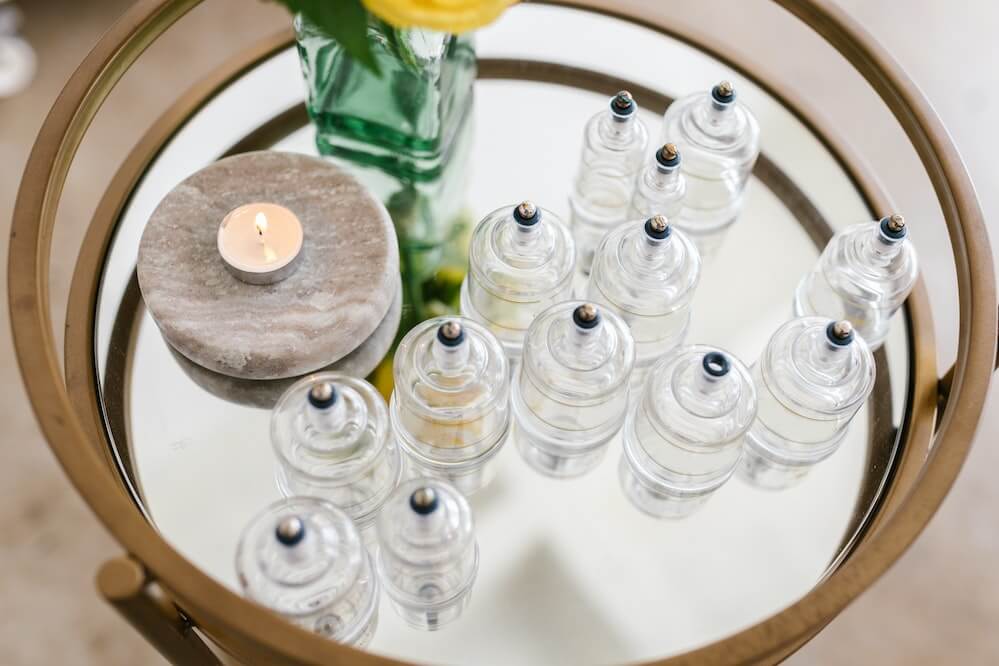Welcome to our deep-dive exploration into the world of alternative therapies. Here, we’ll compare two ancient healing practices often steeped in mystery and misconceptions: cupping vs. acupuncture. We’ll delve into their origins, procedures, benefits, and more.
Whether you’re a seasoned practitioner, a patient considering these therapies, or just an inquisitive reader, we aim to offer a comprehensive viewpoint that enables you to make more informed decisions about your health and well-being. Join us as we unravel the intricacies of these age-old practices.
Understanding Cupping

Cupping therapy is an ancient healing practice involving suctioning the skin with cups to improve blood flow, reduce pain, boost the immune system, and more. This treatment can be effective in alleviating many conditions, such as:
-Headaches and migraines
-Gastrointestinal disorders like irritable bowel disease
-High blood pressure
-Arthritis
-Asthma
-Back, neck, knee, and shoulder pain
-Carpal tunnel syndrome
The main four categories of cupping are:
-Dry cupping: It’s a suction-only technique
-Wet cupping: Involves controlled medicinal bleeding
-Flash cupping: It’s a quick, repeated suction and release of cups technique
-Running cupping: Involves moving the cups around the body to massage the desired area
Understanding Acupuncture

Acupuncture is an alternative medicine technique used for treating many conditions by puncturing specific points in the body with thin, metallic needles. It can be effective for treating:
-Headaches
-Anxiety and depression
-Migraines
-Sprains
-Insomnia
-Chronic pain (neck, knees, and back)
-Hypertension
Cupping vs. Acupuncture
Cupping therapy and acupuncture have a long history of use for treating various conditions. But what makes these practices different, and are there any similarities? Let’s find out!
Similarities between cupping and acupuncture
With all their differences, cupping and acupuncture still have some similarities, such as:
–Origins in TCM: Cupping therapy and acupuncture have a similar background to traditional Chinese medicine (TCM), and both are rooted in the belief that the body is an interconnected system of energy.
–Energy Flow: One key focus of cupping and acupuncture is to stimulate energy points in the body and regulate energy flow to promote healing and overall well-being.
-Therapeutic Effects: Both cupping and acupuncture can have therapeutic effects on the body, such as improving circulation, reducing inflammation, easing pain, and promoting relaxation.
-Holistic Approach: Being alternative treatments means that these practices adopt a holistic approach and give equal importance to treating the physical, emotional, and mental well-being.
Differences between cupping and acupuncture
Some of the key differences between cupping and acupuncture include:
-Technique and Tools: Cupping involves placing cups on specific body areas where they suction on the skin. Conversely, the acupuncture technique involves puncturing the skin with thin needles to stimulate energy flow. The material of the cups used during cupping can be glass, metal, plastic, silicone, bamboo, and ceramic, whereas acupuncture uses sterile, thin, metallic needles.
-Sensations: Due to the suction effect, cupping can create mild to moderate discomfort (tight sensation), whereas acupuncture produces de qi or needle sensations (tingling, dull ache, heaviness, etc.).
-Marks on the Skin: While acupuncture doesn’t usually leave marks on the skin, cupping leaves temporary marks caused by the suction effect.
-Stimulation Points: While acupuncture involves puncturing the skin in specific acupoints in the body, cupping utilizes broader areas of the body, mainly focusing on the five meridians on the back.
Use case scenarios: When to use which?
Choosing when to use cupping or acupuncture depends on personal preferences, treatment goals, conditions, etc. Depending on the ailment, it’s best to use cupping for musculoskeletal conditions, respiratory issues, and detoxification. In contrast, it’s best to use acupuncture for pain management, stress and anxiety, and chronic diseases like rheumatoid arthritis.
Combining Cupping and Acupuncture

While these techniques are beneficial on their own, combining them has shown positive results for many conditions. For example:
-The combination of acupuncture with cupping therapy can be effective for treating intractable hiccups.
-This combination therapy can be effective in treating idiopathic scoliosis.
-Combining acupuncture, cupping, and medicine has a therapeutic effect on fibromyalgia syndrome.
-The combination of auricular acupuncture with cupping therapy can be effective in treating chronic back pain.
The Bottom Line
In wrapping up this exploration into the world of cupping and acupuncture, we hope that the knowledge shared has enriched your understanding and dispelled any misconceptions.
Both these ancient practices, unique in their approaches and techniques, offer varied pathways to wellness. The choice between them depends on personal preferences and individual health objectives. Remember, health is a personal journey, and the most beneficial therapy is the one that resonates with you.
Want to experience the benefits of these amazing treatments firsthand? Here at our Holistic Wellness Center based in Columbus, Ohio, you’ll get the chance to receive cupping and acupuncture treatment tailored to your individual needs. You can book an appointment here and discover the benefits of cupping and acupuncture now!
Frequently Asked Questions (FAQs)
What are the benefits of cupping therapy vs. acupuncture?
Cupping therapy is known for promoting relaxation, easing muscle tension, and enhancing blood flow. It’s often used to relieve back and neck pains, stiff muscles, anxiety, fatigue, migraines, rheumatism, and even cellulite.
On the other hand, acupuncture is highly recognized for its ability to balance the body’s energy pathways or “qi”. It can be used to address a wide array of conditions, including chronic pain, arthritis, anxiety, insomnia, depression, migraine, nausea, postoperative pain, and certain digestive disorders.
It’s important to remember that individual responses to these therapies can vary, and the effectiveness of both treatments often depends on the specific condition and the individual’s overall health status.
Is acupuncture painful?
No, in general, acupuncture isn’t supposed to hurt. However, you may feel some mild discomfort during the procedure. If you feel pain, you should communicate with your practitioner so that they can reposition the needles.
What precautions should be taken before undergoing cupping or acupuncture treatment?
Before undergoing cupping or acupuncture treatment, it’s crucial to ensure the practitioner is licensed and has a solid reputation. Inform them about your complete medical history, including any medications or supplements you’re currently taking and any existing health conditions.
For both treatments, it’s usually recommended to have a light meal beforehand. You should also be well-rested and hydrated. Try to avoid heavy physical exertion immediately before or after a session.
In terms of cupping specifically, be aware that it can leave temporary marks or bruises on the skin. If you have a bleeding disorder, severe skin condition, or are pregnant, you should discuss these factors with your practitioner before proceeding.
For acupuncture, if you have a pacemaker, are pregnant, or have a bleeding disorder, it’s important to inform your practitioner, as these conditions may affect the treatment plan.
In both cases, remember to follow any specific instructions your practitioner provides to ensure a safe and beneficial treatment.
Are there any side effects of cupping and acupuncture?
Cupping and acupuncture are safe practices with mild, short-term side effects. Potential side effects after cupping therapy are nausea, fatigue, bruising, dizziness, sweating, mild soreness, and pain. Side effects of acupuncture may include fatigue, bleeding and bruising where the needles puncture the skin, dizziness, drowsiness, mild pain, etc.
Are cupping and acupuncture recognized by modern medicine?
Although they’re not widely recognized by modern medicine, they’re gaining acceptance as complementary treatments for reducing pain, inflammation, stress, anxiety, etc. It’s important to note that there’s so much that we don’t know about these practices and alternative medicine practices in general. This is why they’re being actively researched to understand how they work and the full scope of their benefits.
How long does a typical cupping or acupuncture session last?
In general, an acupuncture session lasts 30 to 60 minutes and can potentially last 90 minutes or more. Depending on the technique used, a cupping therapy session can last 10 to 60 minutes or more. For example, flash cupping usually takes only 5 to 10 minutes.
How many sessions of cupping or acupuncture will I need?
The number of cupping or acupuncture sessions needed varies greatly depending on the individual and the specific condition being treated. For some acute conditions, a single session might show immediate results. However, chronic issues typically require multiple sessions over a longer time period. For instance, it’s common to start with weekly sessions and then gradually decrease the frequency as symptoms improve.
Ultimately, a treatment plan should be discussed and determined with your practitioner based on your individual health situation and goals. Remember that everyone’s body responds differently to these treatments, so progress can be different for each individual.
Will my insurance cover cupping or acupuncture treatments?
It depends. Many insurance companies have begun covering acupuncture for certain conditions like back, knee, and neck pain due to osteoarthritis and side effects from chemotherapy. On the other hand, cupping therapy isn’t usually covered by health insurance plans. However, you can still use employee health benefits sources like Health Savings Account (HSA) and Flexible Spending Account (FSA) to pay for cupping and acupuncture sessions.